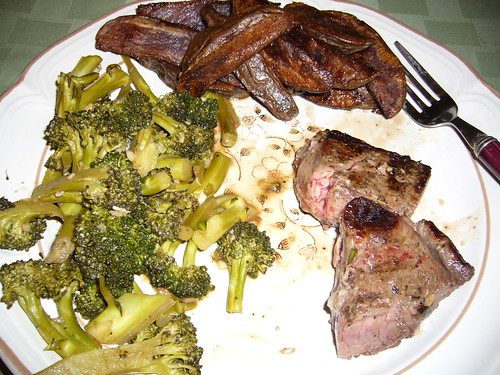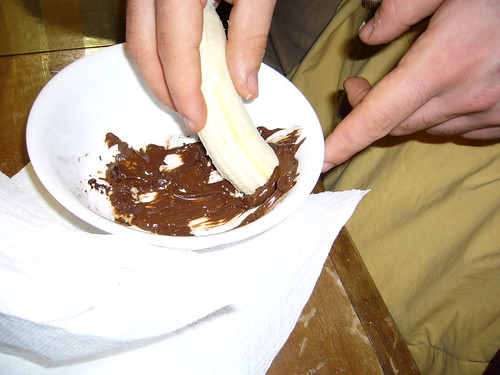
Yesterday I finally set out to recreate the
scallop and beet dish I enjoyed at
Gramercy Tavern last month. The journey began with a stop at the Union Square Greenmarket for bacon from
Flying Pigs Farm. Jesse and I are both bacon neophytes. My parents never
ever cook the stuff because they think any fat at all will kill you (even good fat like avocado). So we found ourselves a bit overwhelmed, both my the claustrophobic crowds at the Greenmarket, and by the assorted selection of bacons - smoked bacon, shoulder bacon, loin bacon, Canadian bacon, fully cooked bacon. Part of the problem was Jesse's confusion about what bacon is. He was worried that smoked bacon was already cooked and not what we were looking for, not realizing that it is
the curing and smoking process that makes a slice of pig into bacon. Eventually, this problem was sorted out after many questions, so we purchased some regular smoked bacon from their happy pig farm and went on our way.

Our way being an hours-long trek in and around shoe stores in Manhattan looking for the perfect new sneakers for Jesse. (Isn't it usually the guy who finds himself being dragged around while his girlfriend goes shopping? Not in our relationship.) By the time we got home, my feet were killing me (I probably needed new shoes more than Jesse but have an aversion to shopping) and I was exhausted. I threw the beets in the oven, and then we headed to our favorite beer bar,
Spuyten Duyvil for an aperitif. A nice warming glass of a mild Sirah for me, and a big bottle of
Green Flash Imperial IPA for Jesse (so bitter and hoppy it smelled like a field of grass), along with a little cheese tasting was just what I needed to take the edge off. Spuyten always has a nice selection of cheeses, which they serve with wonderfully soft and airy bread. I love this bread, I adore this bread, and I aspire to someday be able to make it myself. It tasted perfect wrapped around a little piece of
Midnight Moon, a dense, nutty, aged goat cheese.

Onward to dinner. While the beets continued to roast, Jesse fried up a few strips of bacon and then seared the scallops in the bacon fat. When I asked him how he knew how long to cook the scallops, he replied "I just know - I come from the sea, I am a merman!" in true Sir Fishmonger style. The bacon and roasted beets were sliced and diced and mixed together, and topped with the tender little scallops. It wasn't quite the same as Gramercy Tavern, which used a yogurt to thicken the beets into a sauce - I thought this step unnecessary, and I was right because it was truly delicious anyway. Gramercy Tavern also grilled their scallops, but I wanted to put that bacon fat to use and cook the scallops right in it. The recipe, provided at bottom, could not be simpler, and the bacon bits provided a perfect salty, tangy crunch to the sweetness of the beets and scallops.

After dinner, we headed to Chelsea Brewing Company for further alcohol imbibing at the
Manhattan Cask Ale Festival. To get there, we had a sketchy-as-hell-I-don't-get-Chelsea-or-why-people-think-it's-cool-to-go-to-clubs-next-to-sketchy-parking-lots walk from the subway to the Chelsea Piers. But once inside, the place was bustling with people and beer. For those of you not in the know,
cask ale is unfiltered beer allowed to mature naturally in a cask, producing smooth and complex beers without annoying carbonation. They had something like 25 beers to choose from. Standouts included
Sixpoint Apollo (Jesse is in love with any and all Six Point beers) and Southampton beers.

That's Jesse grimacing at the taste one beer that was really awful - it was called Wicked Willie's and it tasted like a shot of bad whiskey and a PBR brewed together.

That's me enjoying something more delightful,
Doc's Draft Cassis Cider, which of course I had to get because it's brewed in my hometown. I liked it better than their regular cider because it was a little sweeter.
And with that, we headed back out into the grunge of Chelsea and the subway toward our home after a long day.
 Pan-seared Scallops with Roasted Beets and Bacon
Pan-seared Scallops with Roasted Beets and Bacon4 small beets
1 tbsp olive oil
4 strips bacon
1/2 lb scallops
Preheat the oven to 400. Scrub the beets and place them in a pan. Drizzle olive oil over them, cover pan with foil, and roast in the oven for about an hour until you can easily stick a fork in them.
Meanwhile, after the beets have been roasting for about 45 minutes, lay the bacon in a large pan and cook over medium low heat, turning every so often until both sides are browned. Remove to a plate lined with paper towels to drain off some of the fat.
Cook the scallops in the bacon fat over medium-low heat, for about five minutes on each side. Do not overcook, as this will make the scallops tough.
Remove the beets from the oven and let cool a few minutes. Peel the beets under cold water running in the sink, and then cut into small slices. Tear the bacon into little bit-sized pieces. Mix the bacon in with the beets, and top with scallops. Pair with a dry white wine (our white was too sweet). Bon appetit!



















































